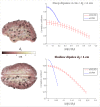On the Potential of a New Generation of Magnetometers for MEG: A Beamformer Simulation Study
- PMID: 27564416
- PMCID: PMC5001648
- DOI: 10.1371/journal.pone.0157655
On the Potential of a New Generation of Magnetometers for MEG: A Beamformer Simulation Study
Abstract
Magnetoencephalography (MEG) is a sophisticated tool which yields rich information on the spatial, spectral and temporal signatures of human brain function. Despite unique potential, MEG is limited by a low signal-to-noise ratio (SNR) which is caused by both the inherently small magnetic fields generated by the brain, and the scalp-to-sensor distance. The latter is limited in current systems due to a requirement for pickup coils to be cryogenically cooled. Recent work suggests that optically-pumped magnetometers (OPMs) might be a viable alternative to superconducting detectors for MEG measurement. They have the advantage that sensors can be brought to within ~4 mm of the scalp, thus offering increased sensitivity. Here, using simulations, we quantify the advantages of hypothetical OPM systems in terms of sensitivity, reconstruction accuracy and spatial resolution. Our results show that a multi-channel whole-head OPM system offers (on average) a fivefold improvement in sensitivity for an adult brain, as well as clear improvements in reconstruction accuracy and spatial resolution. However, we also show that such improvements depend critically on accurate forward models; indeed, the reconstruction accuracy of our simulated OPM system only outperformed that of a simulated superconducting system in cases where forward field error was less than 5%. Overall, our results imply that the realisation of a viable whole-head multi-channel OPM system could generate a step change in the utility of MEG as a means to assess brain electrophysiological activity in health and disease. However in practice, this will require both improved hardware and modelling algorithms.
Conflict of interest statement
The authors have declared that no competing interests exist.
Figures








References
-
- Cohen D. Magnetoencephalography: evidence of magnetic fields produced by alpha-rhythm currents. Science. 1968;161(3843):784–6. - PubMed
-
- Cohen D. Magnetoencephalography: detection of the brain's electrical activity with a superconducting magnetometer. Science. 1972;175(4022):664–6. - PubMed
-
- Hämäläinen M, Hari R, Ilmoniemi RJ, Knuutila J, Lounasmaa OV. Magnetoencephalography—theory, instrumentation, and applications to noninvasive studies of the working human brain. Reviews of Modern Physics. 1993;65(2):413.
-
- Vrba J, Anderson G, Betts K, Burbank M, Cheung T, Cheyne D, et al. 151-Channel whole-cortex MEG system for seated or supine positions In: Yoshimoto T, Kotani M, Kuriki S, Karibe H, Nakasato N, editors. Recent Advances in Biomagnetism. Sendai, Japan: Tohoku University Press; 1999. p. 93–6.
-
- Hämäläinen MS, Ilmoniemi RJ. Interpreting magnetic fields of the brain: minimum norm estimates. Medical & Biological Engineering & Computing. 1994;32(1):35–42. - PubMed
MeSH terms
Grants and funding
LinkOut - more resources
Full Text Sources
Other Literature Sources

